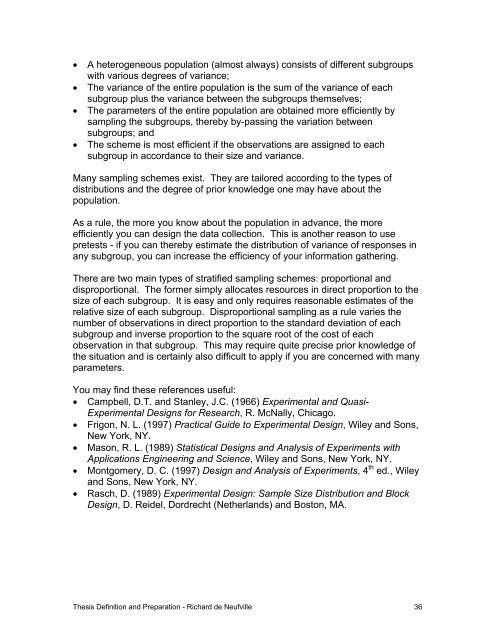Richard de Neufville's TPP SM Thesis Manual - Title Page - MIT
Richard de Neufville's TPP SM Thesis Manual - Title Page - MIT
Richard de Neufville's TPP SM Thesis Manual - Title Page - MIT
- No tags were found...
Create successful ePaper yourself
Turn your PDF publications into a flip-book with our unique Google optimized e-Paper software.
• A heterogeneous population (almost always) consists of different subgroupswith various <strong>de</strong>grees of variance;• The variance of the entire population is the sum of the variance of eachsubgroup plus the variance between the subgroups themselves;• The parameters of the entire population are obtained more efficiently bysampling the subgroups, thereby by-passing the variation betweensubgroups; and• The scheme is most efficient if the observations are assigned to eachsubgroup in accordance to their size and variance.Many sampling schemes exist. They are tailored according to the types ofdistributions and the <strong>de</strong>gree of prior knowledge one may have about thepopulation.As a rule, the more you know about the population in advance, the moreefficiently you can <strong>de</strong>sign the data collection. This is another reason to usepretests - if you can thereby estimate the distribution of variance of responses inany subgroup, you can increase the efficiency of your information gathering.There are two main types of stratified sampling schemes: proportional anddisproportional. The former simply allocates resources in direct proportion to thesize of each subgroup. It is easy and only requires reasonable estimates of therelative size of each subgroup. Disproportional sampling as a rule varies thenumber of observations in direct proportion to the standard <strong>de</strong>viation of eachsubgroup and inverse proportion to the square root of the cost of eachobservation in that subgroup. This may require quite precise prior knowledge ofthe situation and is certainly also difficult to apply if you are concerned with manyparameters.You may find these references useful:• Campbell, D.T. and Stanley, J.C. (1966) Experimental and Quasi-Experimental Designs for Research, R. McNally, Chicago.• Frigon, N. L. (1997) Practical Gui<strong>de</strong> to Experimental Design, Wiley and Sons,New York, NY.• Mason, R. L. (1989) Statistical Designs and Analysis of Experiments withApplications Engineering and Science, Wiley and Sons, New York, NY.• Montgomery, D. C. (1997) Design and Analysis of Experiments, 4 th ed., Wileyand Sons, New York, NY.• Rasch, D. (1989) Experimental Design: Sample Size Distribution and BlockDesign, D. Rei<strong>de</strong>l, Dordrecht (Netherlands) and Boston, MA.<strong>Thesis</strong> Definition and Preparation - <strong>Richard</strong> <strong>de</strong> Neufville 36
















